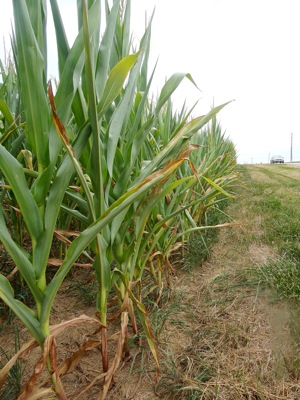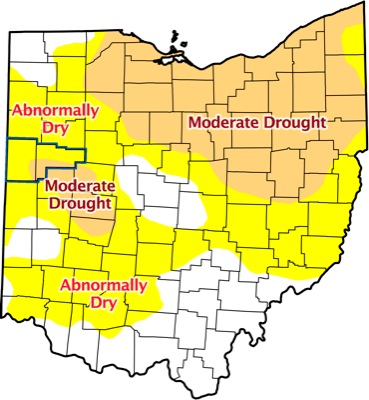Thursday, July 28th, 2016
Lack of rain hurting crops
Lower prices are a concern
By Nancy Allen

Photo by Nancy Allen/The Daily Standard
Leaves on these corn plants along Clover Four Road just east of U.S. 127 are curling and turning brown, both signs of insufficient moisture. Many area farmers are expected to experience yield losses due to the dry conditions. A small part of Mercer County south of Grand Lake along the border with Auglaize County and the lower third of Auglaize County are in a moderate drought, according to the USDA's drought monitor.
Many local farmers will see yield losses due to dry weather and drought conditions.
Combine that with lower market prices for corn and soybeans, and farmers could be facing a tough year, local ag officials say.
"We could see at least a 35 percent yield loss overall for the corn crop, but if we get a good rain it may prove me wrong," said Michelle Stahl, Mercer County Farm Service Agency acting executive director.
She estimates a 20 percent overall yield loss for soybeans in the county.
Anita Green, Auglaize County FSA executive director, said it's too early to predict yield losses for her county but noted they could be significant.
"We have cropland that is certainly stressing with indications there will be significant yield losses in that (drought) area in both corn and soybeans," Green said.
According to the U.S. drought monitor map, most of Mercer County is abnormally dry while a small section south of Grand Lake along the border with Auglaize County is in a moderate drought. The lower third of Auglaize County is in a moderate drought while the upper portion is abnormally dry, the map shows.
Corn is suffering more than soybeans because much of the local corn is in its critical pollination stage. Soybeans are still hurting but have more growing time to rebound if timely rains come, Green said.
Auglaize County has some excellent crops toward New Knoxville, New Bremen and Maria Stein - areas that have received more rain. But these are small areas, Green said.
Both Green and Stahl noted the dry weather will impact cattle and dairy farmers who grow forage such as hay and silage for their livestock. They will need to purchase feed elsewhere, resulting in higher costs.
Livestock producers with feed losses and animal deaths resulting from adverse weather may be eligible for assistance through the FSA, both Stahl and Green said.
"It's not what we like to see," said Celina area farmer Randy Thomas. "Our yields will be considerably lower and the prices (for corn and soybeans) have dropped off."
Prices at Mercer Landmark on Wednesday were $3.51 per bushel for cash corn and $9.86 per bushel for soybeans. This is down from a high of $4.52 for corn on June 27 and a high of $11.69 for soybeans on July 1.
Thomas said his crops don't look too bad yet and attributed their current resilience to good root development.
"But it's getting to where it's more serious all the time," he said.
Thomas said he is watching out for spider mites in his soybeans. The insect pest thrives in drier conditions. Mites damage plants by piercing the underneath part of leaves and feeding on the plant juices.
"If you got 'em, there is a certain point to where you've got to spray 'em," he said.
Denny Riethman, Mercer County OSU Extension agent, encouraged farmers to scout for the mites in their fields. Hold a black piece of paper under the leaves of the plant and tap the plant to make any fall off, he said.
"They're so small they look like specks of dust," he said. "If they're moving, you know they're spider mites."
New Bremen area farmer Leon Heitkamp said his crops are holding their own, but they need water.
"They're faring better than you would think with all the genetics in 'em, but we need some rain," Heitkamp said.
Heitkamp said the condition of farmers' crops depends on many factors. For some, it may be a bad year; it just depends, he said.
"It depends on where your land is, when (crops) were planted, how much rain you got, the soil conditions and other things," he said. "It all makes a difference."
Thomas said he's been through dry spells before.
"We've always made it through," he said. "In some ways all you can do is just watch your spending and hope for a better year."
Pray for rain:
Day after day the sun shone out
Till the earth was choking with dust and drought,
And millions of blossoms on hill and plain
Were almost dead for the want of rain.
All through the meadows the heads of wheat
Bent low with the long-continued heat,
And the farmer murmured: "No crop of grain
Shall I harvest this year if it doesn't rain."
The clouds hung heavy in hearts that knew
How much depended on the rain and dew,
And tears were plenty as the days went by
But clouds and tears were not in the sky.
Our Willie noted the frown that lay
On his father's forehead from day to day
And longed to banish with loving art
The fears that troubled the farmer's heart.
"Mommie, do you think that God will hear
If I pray for rain?" "Why of course, my dear,"
Was the mother's earnest and prompt reply.
"Well then," said Willie, "I mean to try."
At bedtime, Willie, overcome with play,
Forgot the prayer that he meant to say.
But the angels, watching his slumber, guessed
The thought that lay within his breast.
Next morning, all over the thirsty plain,
Was heard the steady drip of the rain.
And Willie, overjoyed at the welcome sight,
Said: "Who prayed for rain last night?"

Submitted Photo
The USDA's drought monitor map shows degrees of dryness for the Buckeye State. The map shows parts of Mercer and Auglaize counties are in a moderate drought and other areas are abnormally dry.

